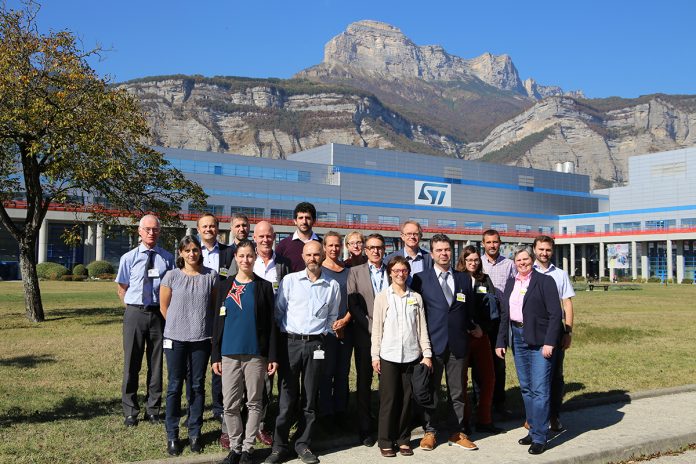Here, Dr Dimiter Prodanov discusses the results and perspectives of NanoStreeM, a consortium which examines occupational safety of nanomaterials
Nanomaterials are used in many industrial applications. Desirable characteristics, subject to optimization, can include increased strength of the nano-enabled material, its chemical reactivity, or altered electrical properties. Engineered nanomaterials, ENMs, are incorporated in a wide variety of consumer products: from cosmetics and paints to sportswear, mobile phones, computer chips, and batteries. Such materials represent bottom-up nanotechnology, where particles, fibres or surfaces are synthesized from molecules. In contrast, top-down nanotechnology can be exemplified by semiconductor processing, where nano-scale features are patterned with exceptional precision on macroscopic objects. In the concrete case of the semiconductor industry, there are more than 200 chemical compounds consisting of elements, such as silicon, germanium, copper, gold, hafnium, indium among many others, which are present in most computer and mobile phone chips. In some chip manufacturing processes, ENMs enable superior yields and performance. Other examples include solar cell industry and energy storage, where a number of diverse materials based on rare earth elements are used. Every one of these applications requires unique expert insight into possible consumer, occupational or environmental hazards.
Risk assessment
It is generally anticipated that the recently developed first-generation and upcoming second generation active nanomaterials pose challenges for assessing their risks. Therefore, a variety of new risk assessment tools have been developed. Acceptance and use of one or another risk assessment framework can have a wide range of economic and safety repercussions, therefore it is of considerable science policy interest. For example, in the European Union, nanosafety research has been supported throughout the last 3 EU Framework Programmes. Whereas only five nanosafety projects were funded in the 6th Framework Programme, around 50 projects and initiatives on nanosafety were funded in the 7th Framework Programme, between 2007 and 2013. By 2018, 19 projects had been funded under H2020. In the USA, the National Institute of Occupational Safety and Health (NIOSH) is the leading federal agency conducting research and providing guidance on the occupational safety and health implications and applications of nanotechnology. International regulatory science efforts are coordinated by the Organisation for Economic Co-operation and Development (OECD). On the other hand, it should be noted that partially because of this vigorous science policy interest, the number of publications dealing with the toxicology of nanomaterials has increased tremendously, although most studies are not directly applicable in industry setting for risk assessment of Engineered Nanomaterials (ENMs).
Occupational safety
Throughout its operation from 2016 till 2018, the NanoStreeM consortium defined a road map of occupational safety of nanomaterials in nanoelectronics where we have identified the existing gaps in the present knowledge and formulated a number of recommendations for their mitigation. Definite needs for competencies development were established in terms of informing about the physicochemical properties of nanomaterials, a dedicated nanotoxicology knowledge base, and about the limitations of the traditional occupational chemical risk assessment. To meet these needs, the project composed nanosafety training packages, as one of its major outcomes. As a final outcome, the project partners Tyndall, The French Alternative Energies and Atomic Energy Commission (CEA), and Imec composed three dedicated training courses focusing on semiconductor industry processes and the cleanroom environment. Developed training packages will be used by the semiconductor industry and the partnering institutions after the end of the project.
Assessment of the risks, related to nanotechnology innovation, requires an integrated multidisciplinary approach due to the complexity of the interactions on the nanoscale. On the other hand, the safety of nanomaterials and nanotechnology cannot be considered on a case-by-case basis. A systematic framework for risk governance should be centred on generic principles, such as Safe by Design. Conversely, concrete implementations of such principles can be sector-specific. In the engineering context, Safe by Design implements the integration of hazard identification and risk assessment methods early in the design process to eliminate or minimize the risks of harm throughout the construction and life of the product being designed. Safe by Design includes three components: safe design, safe production, and safe use. In the context of the semiconductor industry “safe design” translates to development of processes, where the used nanoparticles have known hazards. “Safe production” entails a reduction of process hazards at identified hotspots of risk. “Safe use” ought to consider issues, related to recycling and end-of-life. Such knowledge then may be used to inform design choices.
The NanoStreeM project
The NanoStreeM project demonstrated that the nanoparticle emissions in normal operation mode are not likely to occur. Therefore, future studies in the semiconductor industry should focus on the assessment of the fully lifecycle, including the environmental impact, product end-of-life, and recovery of valuable elements through recycling. Finally, the NanoStreeM project has identified some key challenges and data gaps, which the industry is facing. On the first place, it is lack of reliable data on nanoform toxicity. Persistence of such gap inadvertently leads to uncertainty in regulations. Therefore, it is necessary to identify how much uncertainty is acceptable in terms of cost and impact. Secondly, risk assessment methods for nanomaterials are far from mature, which makes their application very difficult in an industrial setting. Therefore, innovation guided by the Safe By Design principle must be aided by ongoing and future regulatory research. Finally, it will be important to identify appropriate sources of information and communication channels for all actors along the supply chain, including the general public.
Acknowledgment
The NanoStreeM (Nanomaterials: Strategies for Safety Assessments in Advanced Integrated Circuits Manufacturing) project receives funding from the European Union’s Horizon 2020 Research and Innovation Programme under grant agreement n° 688794.
Please note: This is a commercial profile











